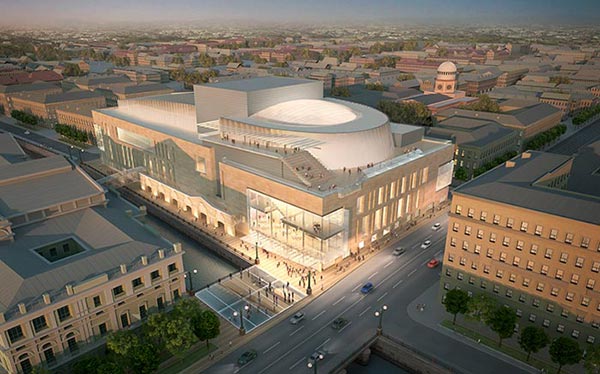The Mariinsky Theatre in St. Petersburg was named for the Empress Maria Alexandrovna, wife of Alexander II, and held its first performance in 1860. It was around this time that Fyodor Dostoevsky was hitting his stride. In 1864, his novel Notes from Underground was published; it is narrated by an unnamed retired civil servant living in St. Petersburg. Dostoevsky had noted the influence of the West on Russian culture: “Why, everything, unquestionably almost everything that we have—of development, science, art, civic-mindedness, humanity, everything, everything comes from there—from that same land of holy wonders!” Dostoevsky was worried that the Russian soul was being displaced by foreign content. His narrator is a spiteful bureaucrat who shares this view and warns that we can’t trust him to tell the truth; he doesn’t even trust himself. Notes from Underground has been called the first existential novel (by Sartre, no less), and it could serve as a guide to the several competitions to build a new Mariinsky Theatre.
The original Mariinsky is picturesque but antiquated, and in 2001 the Russian government decided to build another concert hall—the Mariinsky II—on a site across the narrow canal that once housed the wonderfully Soviet-named Palace of Culture in Honor of the First Five-Year Plan.
The building of the second Mariinsky was called the most important piece of Russian architecture in seventy years. It was important for several reasons. There hadn’t been much notable architecture during that time in Russia, for one. But it was also important as a symbol. One year into Vladimir Putin’s presidency, Russia was stranded between communism and democracy, was struggling economically (though gaining ground quickly through oil exports), and had little cultural imprint outside its borders. But one of its cultural successes was Valery Gergiev, the fifty-six-year-old conductor of both the Mariinsky Theatre Symphony Orchestra and the London Symphony Orchestra, and a regular guest conductor at the Metropolitan Opera House in New York. Gergiev has been artistic director of the Mariinsky (then named the Kirov) since he was thirty-five, a wunderkind who has rock star status in Russia. He is also a friend of prime minister Vladimir Putin, whom he met when Putin was deputy mayor of St. Petersburg. The idea was to build one of the world’s great cultural centres—one that would include the original Mariinsky, a small concert hall (completed now, and called the Mariinsky III), a rehabilitation of the surrounding area, and the centrepiece: the Mariinsky II. The original budget for the concert hall was $100 million, to be paid by the Russian government.
In August 2001, a tender was held for the project, which was won by two American developers who had paired with California architect Eric Owen Moss, whose radical scheme used water and ice as its theme, reflecting St. Petersburg’s canals and its protracted winter. It featured two dramatic, icebergian structures of glass and granite, one of which had a crumpled silhouette that echoed the spires around it. Gergiev initially supported the design, saying, “We’ve got to be radical to attract attention to ourselves.” But it was criticized by both local architects and politicians, and Gergiev’s support waned.
An international architectural competition was then held, with eleven architects invited to submit proposals, among them Eric Owen Moss. In 2003, it was announced that the winner was French architect Dominique Perrault.
During those two years, Russia struggled with democracy. The country’s nascent capitalism was being subverted by oligarchs, the war in Chechnya was escalating, and there was domestic terrorism. Putin chose stability over reform. Russian journalist Anna Politkovskaya (who was murdered in 2006) announced “the death of Russian parliamentary democracy,” but it wasn’t clear what had taken its place. The government was a bureaucratic oligarchy with some of the traits of a right-wing dictatorship. On January 13, 2004, a public opinion poll asked, “Which social institutions do you most trust? ” Only 1 percent of Russians trusted political parties; 50 percent trusted Putin; 28 percent trusted nobody; 14 went with the Russian Orthodox Church; 9 for the army; 9 for the government; 5 for the police; and 3 voted for the trade unions. A Russian poll in every respect, its numbers totalled 128 percent. It was an ill-defined time, politically, culturally, even mathematically.
It was also an ill-defined moment in architecture. The Bilbao Effect, the notion taken from Frank Gehry’s Guggenheim Museum Bilbao, that a single dramatic building can change the face of an institution, a city, of a country even, was on the wane. Gehry himself had pronounced it “dead in the water.” But it continued to influence how public buildings were being conceived. It was clear that some Russians, still emerging from the grey Soviet era, had hoped for this kind of international recognition with both Moss’s and Perrault’s designs.
Perrault’s winning entry featured a gold glass canopy settled almost like a fabric on a whimsical dome that echoed the golden spires of St. Petersburg. “We worked like a clothes designer,” Perrault said, “wrapping the building in a sort of veil.” Gergiev was a juror for the competition and made it known that he liked Perrault’s design. “It seemed to be almost a foregone conclusion that Perrault would be the winner,” said jury member Colin Amery, who voted for another entry (the politically adept Gergiev abstained).
There were immediate concerns about both the cost and the practicality of Perrault’s design. How would the dome be constructed? How would all that glass be cleaned? In his final presentation to the jury, Perrault said they would need to use robots. “It’s very experimental,” he said. “On the other hand, it’s very fashionable.”
When Perrault’s design was reviewed by the dense bureaucratic layers of Russia’s regulatory system, there were 286 official objections. “The criticism is of a serious nature,” said a spokesman for the North-Western Directorate for the Construction, Reconstruction, and Restoration of St. Petersburg. “It concerns the building’s stability, its safety, and the absence of coordination between different parts of the projects done by various subcontractors.”
Perrault was fired in January 2007 for reasons that both his office and Russian authorities defined as complex, a collage of architectural, cultural, and economic issues. “At present, Perrault to us is not a world-renowned architect,” said Mikhail Shvydkoi, head of the Federal Agency for Culture and Cinematography, one of the myriad agencies involved in the construction of a cultural building. “He is just a contractor who does not meet his obligations.”
The fact that Perrault’s design was dismissed as impractical and that he had been publicly fired, however, didn’t mean it wouldn’t be built. There were signed documents from all the pertinent agencies and ministries, and that lumbering bureaucratic momentum was difficult to stop. So they began to build.
In early 2007, Valery Gergiev was in Toronto with the Mariinsky Orchestra, and Richard Bradshaw, general director of the Canadian Opera Company, gave him a tour of the Four Seasons Centre for the Performing Arts, designed by Jack Diamond of Diamond+Schmitt Architects (DSAI). Gergiev told Bradshaw he thought it was magnificent. He admired the design, the acoustics, and the budget. On Gergiev’s next visit to Toronto, in December, Bob Ramsay, a communications consultant and one of the sponsors of the Mariinsky Orchestra’s first visit to Canada, in 2001, organized a dinner for him and invited Diamond.
Gergiev was seated beside Diamond, and they chatted for a several hours about music and opera houses and hit it off. At 1:30 a.m., Diamond excused himself, saying he had to work that day. Gergiev said he had to work as well.
“What are you doing? ”
“Conducting War and Peace at the Met.” Gergiev stayed until 3 a.m., drinking and eating, then flew to New York later that day.
The following May, Gergiev invited Diamond to New York, where he showed him Perrault’s scheme as well as other proposals for the Mariinsky. Diamond was critical. He said the dramatic exteriors had nothing to do with the interiors. Gergiev then invited him to St. Petersburg. He told him Perrault had been fired and asked Diamond to do a design for the Mariinsky. “Draw me a picture,” he said.
“I don’t work like that,” Diamond said.
“I need pictures to show Putin.”
Diamond’s office put together a scheme in five weeks, using the people who had worked on the Four Seasons Centre, and the Harman Center for the Arts in Washington, DC. The Mariinsky had historical and cultural import, and Diamond, the seventy-seven-year-old founder of DSAI, saw it as a coup. It was a high-profile commission that would cement the firm’s growing international reputation. The design team employed some of the tropes from the Four Seasons: the transparency and overhangs, the floating glass stairway, the contextual qualities of the exterior. “Be bolder,” Gergiev said when he saw the drawings.
The bolder version acknowledged the scale of the existing area at the cornice line, but also had a soaring, canopied roofline. “It was the classical problem of them wanting to be bold, but wanting a building that fits in,” Diamond said.
The issue of whether the Mariinsky should be a dramatic, singular statement or a contextual building that fit in with St. Petersburg’s stunning architectural landscape was a particularly delicate one. When Eric Owen Moss’s radical design was rejected, St. Petersburg’s chief architect, Oleg Kharchenko, said the building was a repudiation of Russian history. “You, who have lived in this city for so long, your ancestors who created this city, you did it all the wrong way,” he said. “The right way is this empty nonsense.” The Russians appeared to want the impact a Guggenheim-like sculpture might bring, but wanted their heritage to be recognized and respected as well. (Moss suggested that not only did they not know what they wanted, but they were no longer sure who they were. “Are we a western country; are we an eastern country? Are we a democracy? I don’t think they’ve figured it out,” he told me.)
It was into this conundrum that Diamond+Schmitt arrived. The firm had effectively received the commission from Gergiev, though neither he nor the Mariinsky itself was formally in the political loop. They were users, not clients, and had influence but no actual power. So the commission was a tenuous one.
And in the brief interval between Perrault’s firing and Gergiev’s unilateral hiring of DSAI, another version was being worked on. TDM, a theatre supply company that held the contract to supply the Mariinsky, had hired German acousticians Müller-BBM for the project. Müller asked who the architect was, and was told “we don’t have one,” so they hired an architectural firm they had been working with in Italy, Alvisi Kirimoto+Partners, which was then employed to modify the Perrault scheme.
As a result, the first video conference with DSAI and the ViPS Group, the Russian architecture and engineering firm that is essentially acting as the architect of record, was a surreal tour through the dark soul of Russian bureaucracy. Jack Diamond and principal architect Gary McCluskie (who looks a bit like the actor Alec Baldwin squeezed into a much slimmer frame) tried to present their drawings of the auditorium, but were rebuffed by ViPS. “There is no point in showing us these drawings, because we have an auditorium and we are building it” was their emphatically stated position. To which Diamond and McCluskie responded that they were now the architects, there was a new scheme, and here it was. This went back and forth for four hours without any movement. The bottom line was that ViPS had no interest in wading back into the bureaucracy in order to get new contracts, new documents, and new signatures from party holdovers who had a Kafkaesque appreciation of bureaucracy. In the meantime, they continued to work on a version of the Perrault scheme, one that would be shorter, less intrusive aesthetically, and without the glass dome of the original.
The process of working in St. Petersburg was like going down the rabbit hole. Everything was familiar, yet distorted. DSAI didn’t really have a client, or a contract, and didn’t have the pertinent fire or building codes. As it happens, there are two main building codes for St. Petersburg, SNIP and GOST, and it wasn’t clear which one was being used; and the dialogue among the theatre consultants was like a David Mamet play.
“They sent us fifty-seven regulations, but not the theatre codes.”
“I can see this guy at the meeting. He’s got the theatre code. He won’t give it to us. I ask how wide an aisle has to be. Guy says two and a half metres. Other guy is shaking his head, no.”
“No one in St. Petersburg is talking SNIP.”
“They’re talking GOST.”
“GOST looks like someone’s Ph.D. thesis. I mean, it’s a theory.”
Gary McCluskie discussed the auditorium design with Christopher Pomorski, the deputy director of ViPS. After an hour of unconstructive dialogue, Pomorski said solemnly, “Jack Diamond is ambitious man. Every architect is ambitious.” Pause. “Some people in St. Petersburg, they are also ambitious.” A Russian shrug. What to make of this? A message to be cautious when dealing with local authorities. Diamond was persistent, and he had Gergiev as an ally, but bureaucracy is a powerful force, and for the next several months it appeared to be winning the battle.
In 2009, Putin declared that yet another competition would be held for the design. Among the finalists were Diamond+Schmitt, a German firm, and three Russian firms; in July, it was announced that Diamond+Schmitt had won. But the competition was only for the exterior envelope of the building, and the mechanics of the auditorium and lobby were still being worked on by ViPS. Diamond said it was absurd to marry their envelope with someone else’s interior.
The actual construction on the modified Perrault design hadn’t gotten any further than sinking the piles. Working in DSAI’s favour was the physical challenge of building in St. Petersburg. The city is built on swamp, and the bedrock is thirty-six metres below grade. To sink the piles for Perrault’s structure was a time-consuming engineering challenge, and involved the pouring of two subterranean concrete rafts for further support.
The process was now in its eighth year, it had yielded four architects and no clear design, and the budget had gone from $100 million to more than $400 million. The protracted competitions revealed that the communist-era bureaucracy was intact, and that the Russian construction industry and architectural profession had stagnated. A generation of designers and builders had grown up on a diet of gorgeous historical architecture, mundane government buildings, and substandard concrete apartment blocks. As a result, there was a shortage of both expertise and imagination, and the Russians were not unaware of this.
Officially, ViPS was still involved in the design of the auditorium and lobby, because they had the engineering contract. The key to a concert hall is the auditorium—the acoustics and sightlines; this was what Gergiev had so admired in the Four Seasons (along with its budget of $102 million). This was the essence of the Mariinsky, the aspect that most concerned him as a conductor. And it was now in jeopardy.
DSAI was still working on its own design for the auditorium and lobby. In a through-the-looking-glass moment, ViPS helped facilitate DSAI’s version by setting up necessary meetings. Meanwhile, DSAI was also making surface changes to the ViPS version at their request. So two parallel plans were proceeding, with both parties involved in each. DSAI arranged for a November meeting in Moscow to make the case for its design, but at the last minute the meeting was cancelled by the Ministry of Culture, an ominous sign.
On November 17, ViPS called Diamond and said its version was now definitively the official one. Diamond was furious. “Get Valery,” he called out. Gergiev, who was about to go onstage to conduct his orchestra somewhere in the world, came to the phone.
“I think Mr. Putin has to put his foot down,” Diamond said. “Someone is trying to sabotage us.”
Gergiev said he would look into it and went off to conduct. Diamond called ViPS back. Marina Moukhortova, an architect at DSAI who was trained in Russia, got on the phone with ViPS to translate. The scene resembled one of those Cold War films where nuclear bombs have accidentally been launched by one power.
“They say they have reached the point of no return,” Moukhortova said.
“Find out who’s behind this,” Diamond replied.
A minute of rapid-fire Russian. “There is a state-issued contract,” she said. “It has never happened in Russian reality to walk away from a state project.”
“They’re not saying anything,” McCluskie observed.
The ministry, she said, thinks the DSAI scheme is prohibitively expensive and will have inferior acoustics.
“That’s ridiculous,” Diamond said.
“It’s someone in the ministry.” McCluskie said. “They’re sabotaging us. Who’s behind this? Ask Gutovsky at the Directorate.” (Valery Gutovsky was the director of the North-Western Directorate for the Construction, Reconstruction, and Restoration of St. Petersburg.)
On December 7, 2009, Diamond wrote a letter to the minister of culture, Aleksandr Alekseyevich Avdeyev, saying that the DSAI design would result in better acoustics, sightlines, and architecture, and if they went with an inferior design he would withdraw from the project.
The minister of culture responded that the sightlines and acoustics should indeed be at international standards, but they were going ahead with the ViPS design. In a last-ditch attempt to salvage their design, Diamond asked for a mediator and suggested to Gergiev that Herman Gref—the CEO of Sberbank, Russia’s largest bank, and chairman of the Mariinsky board—would be ideal. Gergiev said it would be better if Diamond approached Gref himself. He did, with the result that Gref appointed his VP, Andrey Stroev, to mediate.
On January 11, 2010, the DSAI team was in Moscow for a showdown. Gergiev was absent. In the boardroom of the Sberbank headquarters were the Russians—ViPS and the Directorate—on one side; on the other, Jack Diamond and Gary McCluskie; Fisher Dachs Associates, who were the theatre consultants from New York; Müller-BBM, the German acousticians; and Halcrow Yolles, the Toronto engineers. It was known that Gergiev endorsed the DSAI scheme. In his blog, Gary McCluskie wrote, “ViPS are clearly lost in their own design with no idea how to achieve the basic balance of requirements for sightlines, balcony apertures, and room form, but they resist taking on our design solution. It is partly pride and control that holds them back from adopting our solution, but more fundamental is a lack of imagination. They don’t really understand the complexity of the room design, yet fear of the unknown holds them back from taking a step towards another solution.”
The meeting resulted in a compromise that essentially used the DSAI design for the lobby and the concert space. The auditorium was contained within a horseshoe-shaped shell dictated by ViPS, the last residue from the Perrault scheme. All of this would exist inside the DSAI envelope: they had reclaimed the design. On January 27, there was a video conference with ViPS to hammer out the details. It was similar to a video conference addressing auditorium and lobby design that had taken place fifteen months earlier. Among the many complications of the auditorium was a large VIP area that had to have a separate entrance and lobby, and required adjacent seats for security people. There was also the discrepancy between the number of seats the Russians wanted (2,000) and the number that could be accommodated that had good sightlines (closer to 1,820).
“If you can’t see the stage,” said Joshua Dachs, the theatre consultant, “if you don’t actually know there is a performer on it, then I don’t know that we can count this as a seat.”
There was a flurry of thoughts on gradients, aisles, and tiers, with the dictate that DSAI had to produce another drawing. Any change in the number of seats upsets the geometric ecosystem of the auditorium: it reverberates throughout the rest of the room, and requires a host of complex adjustments.
“I’m not doing another drawing,” Dachs said.
McCluskie mediated, saying it was necessary.
“I’ll need two days.”
“You have one day,” said Christopher Pomorski of ViPS.
In the small silence that followed this dire deadline, issued after more than a year of obfuscation, Pomorski said, “Sorry I am so aggressive, but I have no time, ha-ha. In private life, I am very polite.”
On February 1, the ministry issued the signed Design Task documents, and the DSAI design officially proceeded. The bureaucracy, that massive beast that has survived since Dostoevsky, through Khrushchev’s peasant rants and Gorbachev’s reforms and Yeltsin’s drunkenness and Putin’s oligarchy, had been outflanked. Diamond was triumphant. “We’ve succeeded where Hitler and Napoleon failed,” he said.
Yet even with this clear victory, there were nagging fears. Could the enigmatic sleeping bear somehow rise up and cancel the contracts, banish the foreigners, and leave the building to die? As the anonymous bureaucrat in Notes from Underground says, “The Final End, gentlemen: better to do nothing! Better conscious inertia!… Even this would be better here: if I myself believed at least something of all I’ve just written. For I swear to you, gentlemen, that I do not believe a word, not one little word.”
This appeared in the May 2010 issue.





